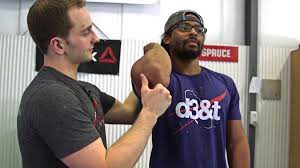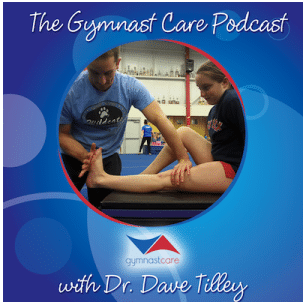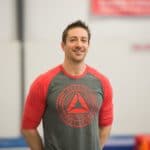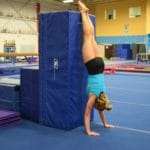Advice To CrossFit Athletes From A Gymnastics Coach, Physical Therapist, and Former Gymnast (Part 1)
After coming back from my first week teaching at Power Monkey Camp, I finally took some time to put an article series together related to some thoughts on gymnastics in CrossFit. I really stand behind Dave Durante’s approach to gymnastics training in CrossFit, both for performance enhancement and injury prevention. You’ll see a lot of references to the Power Monkey content offered by the coaching staff through these posts. I’ve broken this post up into 4 parts. In this article, I wanted to go over a few foundational ideas that I feel are crucial to reducing injury risk and also increasing performance for anyone training gymnastics movements in CrossFit. Then in the new few parts, I’ll offer thoughts more specifically to handstands and swinging mechanics, then offer a post with all my favorite gymnastics/injury prevention drills.

(Photo Credit Barbell Shrugged)
Master Basics, Foundations, and Progressions
If you only take one message away from this article, hopefully it’s this: Gymnastics is a sport built around technical mastery, progression, perfectionism, and literally hundreds of hours in training to develop skills. In my opinion not putting in the time for perfect basics, not revisiting them daily in pursuit of mastery, and skipping steps to get to higher level skills is the biggest root cause of gymnastics skill injury. In parallel to this, I feel the same issue related to skipping steps is also the root cause for performance losses during CrossFit workouts that posses gymnastics skills. If anyone hasn’t read Dave Durante’s latest CrossFit Journal Piece Gymnastics: The Long Journey Worth Taking, your missing out. He discusses a lot of these concepts from his point of view being a former Olympian and someone who is now pursuing teaching the CrossFit community more about gymnastics.
Technical flaws, missing fundamentals, and movement dysfunction rear their ugly head when it comes to grinding through hard workouts. When more complex gymnastics skills are pursued, especially under conditions of fatigue, the lack of foundational basics will be the rate limiter for gymnastics skill success. In the moment, the brain and nervous system seek out the “path of least resistance” to find a strategy to complete the movement. This provides as a short-term solution, but unfortunately for many athletes becomes a long-term problem in their skill performance. Sloppy gymnastics skills, compensation, and faulty movement patterns becomes the default “go to” method in the nervous system.
These problems then stick around and create a cascade of issues during training. Whether it is performance based due to movement inefficiency causing early fatigue, or pain based due to compensatory patterns causing injury, it’s always problematic and frustrating for the athlete. In the same way that technical flaws become exposed when weight increases during snatching, technical flaws become exposed when the skill complexity increases during gymnastics skills.
The point I’m trying to harp on is that missing gymnastics basics, a lack of proper progression, and skipping steps will always catch up with you. If you are a CrossFit athlete who is serious about gymnastics, do yourself a favor and find a good gymnastics coach who can teach the proper progressions and give you a systematic program for skill development. Then, make sure you are disciplined enough to train them, regularly revisit them, and apply them to workouts. Here is a perfect example of this idea from Power Monkey Coach Colin Geraghty related to some technical and progressional components of ring work.
I can tell you from my experiences as a gymnast and coach in the sport, the ratio of basics/technique development to actually doing complicated skills is easily 4:1 in favor of foundational work. Even with this gymnasts constantly revisit body shaping, skill basics, and event basics (rings, tumbling, swinging, etc) every single day of training. The girls gymnastics team I coach does 15 minutes of general basics daily, 10 minutes of basics on each event as a warm up, and usually have 2-3 side stations during events that are just on technique work. This is to ensure proper movement pattern development, safety during skill work, consistency, and build optimal movement patterns they can build on through years of training. Dave Durante has a great video highlighting some of these ideas related to handstand shaping and movement efficiency that everyone should check out.
Concluding Thoughts
For those looking to really dive into movement screening, basics and fundamentals behind gymnastics, and making sure you are prepared to work gymnastics skills, be sure to check out Monkey Method: Movement Essentials that myself and my good friend Dr. Dan Pope put together.
Although it’s more thought and concept related in this first post, I wanted to leave it just at that due to its importance. I feel this concept can have the biggest impact for CrossFit athletes looking to enhance their gymnastics skills and stay injury free in gymnastics skill training. I know it is tedious and frustrating, but that is what makes gymnastics so demanding.The rest of my posts are built off of these underlying concepts. In Part 2, I will talk about how I feel the same movement issue in a handstand can lead to a decrease in gymnastics skill performance, and also shoulder/neck/wrist pain. After this, I’ll walk through some gymnastics movement issues I tend to see related to injury rehab in CrossFit athletes. Take care,
– Dave Tilley DPT, SCS
P.S. and Background
For anyone who most likely finding my work for the first time my name is Dr. Dave Tilley. I was a competitive gymnast for 18 years, 4 of which were collegiately on the Springfield College Men’s team. I’ve been coaching various levels of gymnastics for 11 years, and still actively coach a women’s team in the North Shore of Boston. I am also a treating Physical Therapist at Champion PT and Performance in Waltham, and run a company/website called SHIFT Movement Science and Gymnastics Education. It is dedicated to spreading education on gymnastics, movement science, rehabilitation, and performance concepts.
I treat a lot of gymnasts, but also a lot of Weightlifters and CrossFit athletes. I got involved with CrossFit in 2013 after finishing my DPT and moving to Boston. I have also gone on to become Board Certified in Sports Physical Thearpy, and have been currently pursing my CSCS. I’ve been fortunate to spend a lot of time working with Dave Picardy, owner of North Shore CrossFit/TreeHouse Athletics in Danvers, MA. Dave has a long history of years in CrossFit and is also a high level weightlifting coach, so I’ve been lucky to learn a lot from him. Dave and his staff run a large facility that hosts CrossFit classes, an olympic lifting team, marital arts, running/rowing clubs, personal training, and team strength programs. Our girls gymnastics team also does formal strength/weightlifting under their coaches during the summer.











